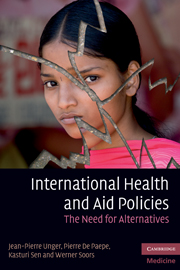Book contents
- Frontmatter
- Contents
- Preface
- Biographies
- Notices
- Acknowledgements
- List of abbreviations
- Reviews
- Introduction: Overview and purpose
- Section 1 Paradigms of international policies
- Section 2 The failure of the aid paradigm: poor disease control in developing countries
- Section 3 Impact of international health policies on access to health in middle-income countries: some experiences from Latin America
- Section 4 Determinants and implications of new liberal health policies: the case of India, China and Lebanon
- Section 5 Principles for alternative, publicly oriented health care policies, planning, management and delivery
- 12 Paradigm shifts in the health sector: mission and methods
- 13 Principles for an alternative, social and democratic health policy
- 14 Quality standards for health care delivery and management in publicly oriented health services
- 15 Principles of publicly oriented health planning
- 16 A code of good practice for the management of disease-control programmes
- Section 6 A public health, strategic toolkit to implement these alternatives
- Conclusions
- Glossary
- Index
- References
12 - Paradigm shifts in the health sector: mission and methods
Published online by Cambridge University Press: 06 December 2010
- Frontmatter
- Contents
- Preface
- Biographies
- Notices
- Acknowledgements
- List of abbreviations
- Reviews
- Introduction: Overview and purpose
- Section 1 Paradigms of international policies
- Section 2 The failure of the aid paradigm: poor disease control in developing countries
- Section 3 Impact of international health policies on access to health in middle-income countries: some experiences from Latin America
- Section 4 Determinants and implications of new liberal health policies: the case of India, China and Lebanon
- Section 5 Principles for alternative, publicly oriented health care policies, planning, management and delivery
- 12 Paradigm shifts in the health sector: mission and methods
- 13 Principles for an alternative, social and democratic health policy
- 14 Quality standards for health care delivery and management in publicly oriented health services
- 15 Principles of publicly oriented health planning
- 16 A code of good practice for the management of disease-control programmes
- Section 6 A public health, strategic toolkit to implement these alternatives
- Conclusions
- Glossary
- Index
- References
Summary
Adapted from: J.-P. Unger. How could disease-specific programmes strengthen health systems delivering comprehensive health care? Strategic and technical guidelines. European Commission, 30 September 2008, Brussels.
Part 1: The need to alter health systems' missions to deliver comprehensive care
The strengthening of health systems appears to have become a motto for international health agencies since 2003, when the former director of the WHO, Jong-Wook Lee (2003–2006), called for a radical re-think of policy, if diseases are to be successfully controlled (Jong-Wook,2003). This view has been echoed by his successor Margaret Chan. However, unlike the growing body of scientific papers that have begun to advocate the strengthening of health systems over the past several years, we would argue that health systems can only be strengthened if they are designed to deliver universally accessible comprehensive care. The remainder of this chapter outlines the rationale for this thinking.
Comprehensive health care: medical and managerial arguments
In a recent address to the 61st World Health Assembly, WHO Director, Dr Margaret Chan, acknowledged that the MDGs had stalled (see Section 1) (Chan, 2008). Besides the MDGs, the control of neglected diseases has also met with difficulties (see Section 1, Chapter 2).
- Type
- Chapter
- Information
- International Health and Aid PoliciesThe Need for Alternatives, pp. 155 - 163Publisher: Cambridge University PressPrint publication year: 2010



